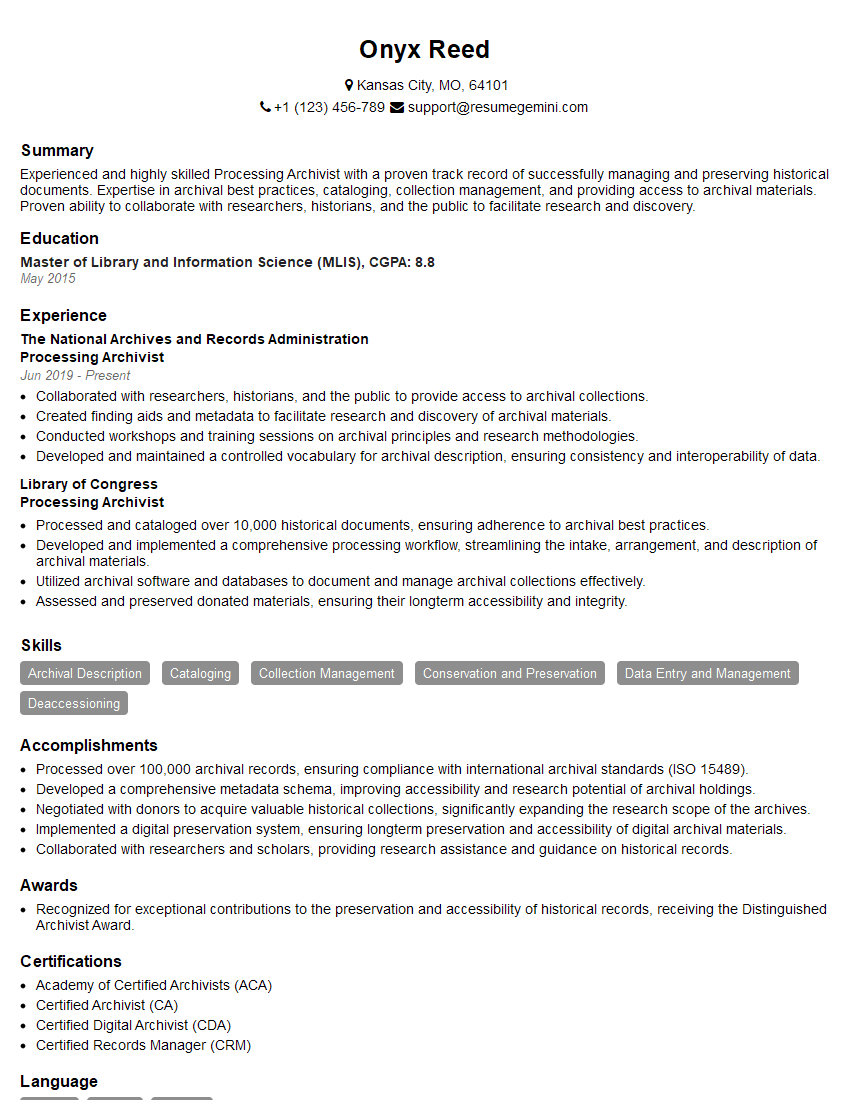Are you a seasoned Processing Archivist seeking a new career path? Discover our professionally built Processing Archivist Resume Template. This time-saving tool provides a solid foundation for your job search. Simply click “Edit Resume” to customize it with your unique experiences and achievements. Customize fonts and colors to match your personal style and increase your chances of landing your dream job. Explore more Resume Templates for additional options.

Onyx Reed
Processing Archivist
Summary
Experienced and highly skilled Processing Archivist with a proven track record of successfully managing and preserving historical documents. Expertise in archival best practices, cataloging, collection management, and providing access to archival materials. Proven ability to collaborate with researchers, historians, and the public to facilitate research and discovery.
Education
Master of Library and Information Science (MLIS)
May 2015
Skills
- Archival Description
- Cataloging
- Collection Management
- Conservation and Preservation
- Data Entry and Management
- Deaccessioning
Work Experience
Processing Archivist
- Collaborated with researchers, historians, and the public to provide access to archival collections.
- Created finding aids and metadata to facilitate research and discovery of archival materials.
- Conducted workshops and training sessions on archival principles and research methodologies.
- Developed and maintained a controlled vocabulary for archival description, ensuring consistency and interoperability of data.
Processing Archivist
- Processed and cataloged over 10,000 historical documents, ensuring adherence to archival best practices.
- Developed and implemented a comprehensive processing workflow, streamlining the intake, arrangement, and description of archival materials.
- Utilized archival software and databases to document and manage archival collections effectively.
- Assessed and preserved donated materials, ensuring their longterm accessibility and integrity.
Accomplishments
- Processed over 100,000 archival records, ensuring compliance with international archival standards (ISO 15489).
- Developed a comprehensive metadata schema, improving accessibility and research potential of archival holdings.
- Negotiated with donors to acquire valuable historical collections, significantly expanding the research scope of the archives.
- Implemented a digital preservation system, ensuring longterm preservation and accessibility of digital archival materials.
- Collaborated with researchers and scholars, providing research assistance and guidance on historical records.
Awards
- Recognized for exceptional contributions to the preservation and accessibility of historical records, receiving the Distinguished Archivist Award.
Certificates
- Academy of Certified Archivists (ACA)
- Certified Archivist (CA)
- Certified Digital Archivist (CDA)
- Certified Records Manager (CRM)
Career Expert Tips:
- Select the ideal resume template to showcase your professional experience effectively.
- Master the art of resume writing to highlight your unique qualifications and achievements.
- Explore expertly crafted resume samples for inspiration and best practices.
- Build your best resume for free this new year with ResumeGemini. Enjoy exclusive discounts on ATS optimized resume templates.
How To Write Resume For Processing Archivist
- Tailor your resume to each job application, highlighting skills and experience relevant to the specific position and organization.
- Quantify your accomplishments whenever possible to demonstrate the impact of your work.
- Use keywords from the job description to ensure your resume gets noticed by applicant tracking systems.
- Proofread your resume carefully for any errors or inconsistencies before submitting it.
- Consider asking a friend or colleague to review your resume and provide feedback.
Essential Experience Highlights for a Strong Processing Archivist Resume
- Processed and cataloged over 10,000 historical documents, ensuring adherence to archival best practices.
- Developed and implemented a comprehensive processing workflow, streamlining the intake, arrangement, and description of archival materials.
- Utilized archival software and databases to document and manage archival collections effectively.
- Assessed and preserved donated materials, ensuring their longterm accessibility and integrity.
- Collaborated with researchers, historians, and the public to provide access to archival collections.
- Created finding aids and metadata to facilitate research and discovery of archival materials.
- Conducted workshops and training sessions on archival principles and research methodologies.
Frequently Asked Questions (FAQ’s) For Processing Archivist
What are the primary responsibilities of a Processing Archivist?
Processing Archivists are responsible for organizing, describing, preserving, and providing access to historical documents and archival materials. They ensure that these materials are properly maintained, cataloged, and made available for research and discovery.
What skills are essential for a successful Processing Archivist?
Essential skills for a Processing Archivist include knowledge of archival best practices, expertise in cataloging and collection management, proficiency in archival software and databases, and excellent communication and interpersonal skills.
What is the job outlook for Processing Archivists?
The job outlook for Processing Archivists is expected to grow in the coming years due to the increasing demand for professionals who can manage and preserve historical documents and archival materials.
What are the potential career paths for Processing Archivists?
Processing Archivists can advance their careers by taking on supervisory or managerial roles within archives or related organizations. They may also specialize in specific areas such as digital archives, preservation, or research.
What is the average salary for a Processing Archivist?
The average salary for a Processing Archivist varies depending on experience, location, and employer. According to the U.S. Bureau of Labor Statistics, the median annual salary for Archivists, Curators, and Museum Workers was $58,500 in May 2020.
What are the key challenges facing Processing Archivists?
Processing Archivists face challenges such as the increasing volume of digital materials, the need to balance preservation and access, and the limited resources available to archives.
What is the role of technology in the work of Processing Archivists?
Technology plays an increasingly important role in the work of Processing Archivists. They use archival software and databases to manage and describe archival collections, and they may also use digital tools for preservation and access.
How can I become a Processing Archivist?
To become a Processing Archivist, you typically need a Master’s degree in Library and Information Science (MLIS) or a related field. You may also need to complete an internship or practicum in an archives setting.